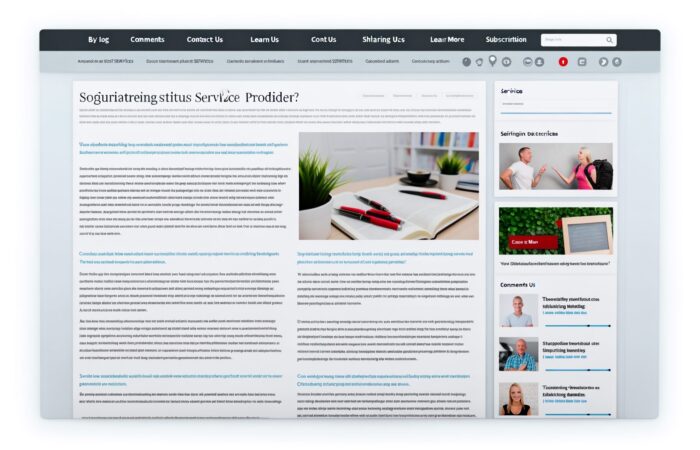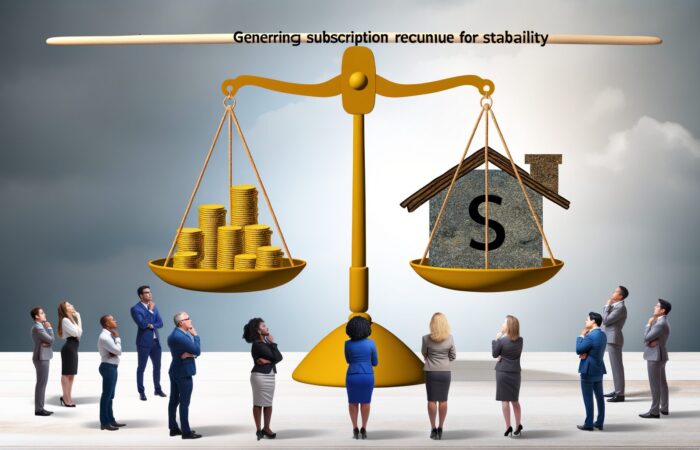Understanding the Basics of Blog Monetization
Hello there! If you’ve ever thought about turning your blog from a hobby into a source of income, you’re at the right place. Blog monetization might sound a bit technical, but it’s really about finding ways to earn money from your blogging efforts. It’s exciting (and quite doable!), so let’s break it down into simple, easy-to-understand components.
First thing’s first: What exactly is blog monetization? In plain language, it means making money from your blog. But, as simple as that sounds, the process involves several strategies and options that can tailor-fit your unique content and audience.
How Does It Work?
Well, imagine your blog is a bustling little café. Just as a café might make money from selling coffee or pastries, your blog can generate income through various channels like advertisements, sponsored content, or affiliate marketing. The idea is to capitalize on the traffic—that’s the number of visitors—you attract to your site.
Different Monetization Models
- Advertising: Ever noticed ads on other websites? As a blog owner, you can sign up with ad networks like Google AdSense, which will pay you to display ads on your blog. Each click or view of these ads churns out some cash.
- Sponsored Content: This is where businesses pay you to write about their products or services. It’s a bit like having a commercial in your blog content, but more nuanced and integrated into your storytelling.
- Affiliate Marketing: Here, you promote someone else’s products and get a commission for every sale made through a link from your site. It aligns beautifully with regular content—just recommend products you genuinely like!
- Products and Services: Got something of your own to sell? Whether it’s an ebook, a craft, or consulting services, your blog can be a potent platform for achieving sales.
Now, not every monetization tactic might suit your style, and that’s okay. The beauty lies in experimentation and finding what meshes best with your blog’s essence and your audience’s preferences.
Getting Started
But how do you start? A solid first step is to ensure your blog is steadily growing in content quality and audience engagement. More valuable content and higher traffic increase potential revenue sources more naturally. It sounds like a marathon, and in some ways it is! But the journey is part of the fun.
Remember, authenticity is key. Readers flock to blogs that maintain a genuine, enthusiastic tonality—just like engaging with a good friend over coffee. Whether you elaborate on the challenges of gardening or review the latest tech gadgets, keeping your voice true to who you are will always resonate with your audience. This connection is crucial, as it’s not just about attracting readers—it’s about keeping them coming back for more.
Starting a monetization journey on your blog can indeed be exhilarating. By understanding the various avenues, gauging what fits best with your content, and maintaining a clear, true voice, you’re setting the stage for potential success. Chart your course, take it step by step, and most importantly, enjoy the process!
Choosing the Right Niche for Your Blog
Okay, now let’s dive into one of the most crucial aspects of a successful blog—picking the right niche. It’s like setting a solid foundation before building your dream house. Sounds exciting, right?
First things first, what excites you? Imagine waking up each morning, thrilled to discuss your blog’s topic. Whether it’s DIY crafts, technology gadgets, mindfulness practices, or exotic cooking recipes, choose a subject you are passionate about. Not only will this make your blogging journey more enjoyable, but your enthusiasm will also resonate with your readers, keeping them coming back for more.
Finding Your Audience
Next up: identifying your target audience. Think about who you are writing for. Are they aspiring chefs? Tech enthusiasts eager to stay on top of the latest gadgets? Or perhaps home decorators looking for budget-friendly tips? Understanding your audience’s preferences and needs will dictate the content you produce and ensure it truly clicks with them.
Analyzing Market Saturation
Now, let’s tackle a tricky part—market saturation. A quick online search can reveal how crowded your chosen niche might be. Don’t be discouraged by a high volume of existing content. Instead, look for angles or subtopics that are underrepresented. This will help you carve out a unique space and grab the attention of overlooked or underserved readers.
Checking Commercial Viability
It’s also crucial to check the commercial viability of your niche. This means ensuring there are sufficient products, services, affiliations, and advertising opportunities related to your topic. For example, if you decide to focus on sustainable living, are there enough sustainable products or services you can promote or review? Do the affiliate marketing opportunities align well with this niche? A monetizable niche isn’t just popular; it also offers financial returns.
Research and Evolution
Last but not least, remember to keep evolving. The digital world is constantly changing, and so are people’s interests and needs. Regularly spend time researching the latest trends in your niche, engaging with your readers to ask what they care about, and staying flexible as you refine and expand your blog’s focus.
- Regular audience engagement keeps your content relevant
- Continuous learning about your niche ensures you stay ahead of trends
- Updating old content can refresh your blog’s appeal
By adequately preparing and selecting a niche you are passionate about, assessing its audience, determining its saturation level, and ensuring its commercial potential, you not only cultivate a blog that stands out but one that can likely turn into a profitable venture. Ready to make an impact with your blog? Let’s shape your passion into profit!
Strategies for Increasing Blog Traffic
So, you’ve picked a winning niche for your blog, and you’re eager to start monetizing it. But before those dollars start rolling in, you need eyes on your pages. Increasing blog traffic isn’t all about chance or witty posts—even meticulously crafted strategy can guide a steady stream of readers your way. Let’s dive into some effective techniques that can help propel your numbers upward.
Quality Content is King
First things first: content is king. Always. But not just any content—high-quality, valuable, and relatable content that meets your audience’s needs and exceeds their expectations. To spice up viewer engagement, blend in different formats such as how-to guides, infographics, and videos alongside your regular blog posts. This variety not only entertains but keeps your audience coming back for more.
Leverage SEO Techniques
Learning the magic of SEO (Search Engine Optimization) can transform your site from undiscovered gem to the talk of the town. Begin with keyword research to understand what potential readers are searching for, then weave these terms naturally into your posts. Don’t forget to optimize post titles and meta descriptions for higher visibility and tap into the power of backlinking by guest posting on other blogs.
Utilize Social Media
Never underestimate the power of social media in boosting blog traffic. It’s not just about posting links to your content; it involves creating a buzzing community around your blog. Engage with your followers through comments, share interesting snippets, and contribute to relevant conversations. Create sharable content and encourage your readers to spread the word through their networks.
Consistent Posting
A blog is much like a garden; it thrives with regular care and wilts from neglect. Develop a content calendar to help you Post consistently. Whether it’s bi-weekly or thrice a month, let your readers know when to expect new content. Remember, consistency maintains audience interest and can boost your SEO rankings.
Email Newsletters
Email newsletters can drive significant traffic to your blog by catching attention right in subscribers’ inboxes. Tease your latest or most popular posts with catchy headlines and compelling content to click through. Use this tactic to make announcements or share exclusive tips with your subscribers, which can increase loyalty and traffic.
Engage in the Community
Actively participating in online forums, comment sections of related blogs, and engaging with relevant social media groups can position you as an authority in your field. People are more inclined to visit a blog when they see thoughtful contributions from its owner elsewhere.
Analyze and Adapt
Lastly, keep an eye on your traffic analytics to understand what’s working and what’s not. Use tools like Google Analytics to track which posts attract more viewers, how long they stay, and their interaction. Adjust your strategy based on factual data to continually optimize your traffic inflows.
In ringing off, boosting traffic to your blog is a mixture of creativity, strategy, and lot’s of patience. Implement these techniques, stay resilient, and watch as your blog blossoms into a thriving hub that not only attracts visitors but converts them into loyal followers.
So, you’ve dialed in on your niche and are seeing a tick upward in traffic numbers? Awesome! Now’s the perfect time to dive into some clever techniques to help actually monetize all that hard work you’ve been putting into your blog. Let’s get cracking!
Implementing Effective Monetization Techniques
Monetizing a blog can feel like fitting together pieces of a jigsaw puzzle. But once it starts taking shape, it’s a beautifully rewarding experience.
Ads — The Classic Approach
First up, good old advertisements. Implementing ads through networks like Google AdSense, Media.net or even more niche-specific ad networks can be a straightforward route to generating income. The special sauce here? Placement and relevance. Badly placed or irrelevant ads can annoy your readers. Aim to blend them seamlessly into your blog’s layout and content stakes.
User-Paid Subscriptions or Premium Content
Is your content king? Then why not place a modest crown on it through gated or premium content?! Chargging subscriptions can work if your content truly carries a unique value — think exclusive insights, in-depth guides, or early access. Start with bite-sized premiums and gauge whether your audience finds enough value to subscribe more comprehensively.
Host Sponsored Posts and Reviews
Engage with businesses relevant to your niche to craft sponsored posts or product reviews. Not only can this be lucrative, but it also provides fresh content and sometimes free products! The key here is transparency and honesty — always clarify sponsored posts to your audience to build trust.
The Exquisiteness of Webinars and Courses
If you’re up for producing more detailed content, consider launching webinars or courses. This is especially potent if you have established authority in your field. By teaching a skill or unraveling complex topics, you offer high-value content that people are willing to pay for. Leverage tools like Teachable or WebinarJam to aid your cause.
Merchandise: Say It with Swag!
Has your brand reach a point where your catchphrases or logos are iconized by your followers? Merchandising can be a fun and profitable pathway. Plying your trade through custom merchandise not only arms your most ardent followers with branded goodies but also spreads your brand’s voice far and wide.
- Stay logical; Start small – a few designs and products are a great bet!
- Use services like Printful or CafePress – they automate a lot of the process.
Beyond these strategies, always remember the golden mantra of monetization – it’s not what you sell, but how you sell it. Focus on aligning every monetization technique closely with your blog’s theme and audience expectations. As you sail deeper into monetizing your passion, let engagement and authenticity don your guide.
And there you have it! A roundup of spry ideas to armor your blog in the best monetization strategies out there. Remember, every blog’s roadmap to revenue varies slightly; take these suggestions, tailor them a bit, and prepare to watch your blog not just grow — but flourish financially!
Leveraging Affiliate Marketing to Boost Income
So, let’s dive deeper into the world of affiliate marketing—a powerhouse tool that, when used shrewdly, can significantly amp up your blog’s revenue. Affiliate marketing, essentially, involves promoting products or services offered by other businesses, and earning commissions from sales or actions completed through your referrals.
Why should you care about affiliate marketing? Well, consider this: It allows you to make money even when you’re asleep! By linking to a product or service once, you have the potential to earn from that link over and over again, whenever one of your readers makes a purchase.
Now, before you think it’s as simple as plastering links across your blog, hold onto your hats—it’s not merely about adding links, but adding the right links strategically.
Selecting the Right Affiliate Programs
- Match your niche: Does aligning with this product make sense on your blog? The fit should be natural. Your audience trusts your recommendations, so endorse products that genuinely interest or benefit them.
- Research reputability: Choose companies renowned for quality and customer service. A well-respected affiliate program can enhance your blog’s credibility.
- Commission structures: Understand the payoff. Look for attractive earning potentials like high commission percentages or lucrative bonus structures.
Effective Placement of Affiliate Links
While it’s tempting to scatter links everywhere, strategic placement will yield better results. Here are some top spots:
- In detailed product reviews where genuine insight convinces readers of value.
- Within tutorial posts, embedding products that enhance the lesson being taught.
- Using call-to-action buttons at the end of relevant content, prompting user engagement.
Note: Transparency is crucial—always clarify that affiliate links are present. Its good to practice, and often required by advertising standards authorities.
Maximizing Affiliate Earnings
Try these tactics to see a boost in your affiliate income:
- Provide exclusive deals or coupons: Work with affiliates to offer special promos or discounts exclusive to your readers. It not only adds value for them but also increases the likelihood of purchases.
- Frequent updates: Affiliate program terms and promotions can change. Stay updated and adjust your links and content accordingly to maximize earnings.
- Monitor and tweak: Use your blog’s analytics to track which affiliate links perform best, and why, then refine your strategy based on these insights.
To truly flourish with affiliate marketing, think of it as nurturing a relationship both with your readers and the affiliate partners. Trust and genuine endorsements are what convert passing interest into profitable action.
So, next steps? Take the plunge, select a couple of strong affiliate programs, and integrate them seamlessly into your content. With a good strategy, and a dash of patience, you’ll be watching your blog’s income reach new heights!
Utilizing Email Marketing to Enhance Engagement and Revenue
If you’ve been following our discussion on blog monetization, you already know that driving traffic and applying efficient monetization techniques are crucial. But let’s not overlook the golden child of digital marketing: email marketing. Engaging with your readers through their inboxes isn’t just personal; it’s profoundly powerful.
Email marketing is akin to inviting yourself into someone’s digital home – their inbox. Here, personal connection blooms, making it a fantastic channel not only for engagement, but also for increasing revenues. Here’s how you can master this art:
1. Building Your Subscriber List
Before anything, you need a list. No, not Santa’s list—your subscriber list! Begin with adding a simple sign-up form on your blog. Incentivize subscriptions by offering a freebie such as an e-book, a mini-course, or access to exclusive content. Remember, the goal is to make your audience feel it’s totally worth sharing their precious email address with you!
2. Crafting Captivating Content
Your emails should be as alluring as your blog posts. Whether it’s behind-the-scenes peeks, personal stories, or relevant advice, strive to offer value that connects and resonates with your readers. Also, ensure consistency in your tone and messaging. If your blog is fun and quirky, maintain that vibe in your emails.
Emoji use? We love seeing emojis in an email, as long as they fit with the brand voice 😉.
3. Personalizing the Experience
Getting personal can make the difference in transforming your email from just another in the influx to a treasure your readers look forward to. Start simple: use their first name. Then, employ segmentation to tailor your content. Have segments for different interests (like DIY projects vs. personal finance in a lifestyle blog). This small step shows you care and improves engagement.
4. Smart Use of Calls-to-Action
A critical yet often overlooked element—CTAs (Calls-to-Action). Whether you want your readers to check out a recent blog post, grab a limited-time offer, or simply follow you on social channels, your calls-to-action guide them to the next step. Just remember; as much as marketers love telling people what to do, the CTA should feel natural and always aligned with the content.
5. Automate to Keep the Flow
Automating your email sequence cannot be stressed enough. Tools like Mailchimp or ConvertKit can help you send welcome emails, post updates, and customized emails, depending on where your reader is in the user journey. Also, automatic emails mean you work less manually, more strategically.
And don’t let the word ‘automation’ throw you off. You can still keep your emails warm and personal!
6. Understanding the Metrics
- Open rates: How many actually open the emails and read?
- Click-through rates: How many click on the links provided in the email?
- Conversion rates: How many perform the desired action, like purchasing an item or signing up for a webinar?
Keeping track helps you see what’s effective and what need tweaking. Plus, it lets you best align your email tactics with overall blog strategies.
As we see, email marketing not only propels engagement but significantly boosts your monetization potential. It brings your audience closer, encouraging a direct and thus richer relationship. Gone are the days of mindless mass-mailing; today’s email marketing is finely tuned to echo with authenticity and personally touch the lives of your readers.
Now that we’ve talked about different ways to monetize and increase engagement on your blog, let’s pivot to one of the most vital aspects of running a successful blog: Measuring and Optimizing Blog Performance for Maximum Profit. Without this, all your efforts might not be as effective as they could be. So grab your notepad, because these tips could be game-changers!
Understanding Key Metrics
First off, you have to get familiar with the metrics that matter. Knowing your traffic, engagement rates, and revenue patterns s essential. Tools like Google Analytics and other plugins will provide insights into where your visitors are coming from, how long they’re staying, and what they’re interacting with the most.
- Page Views and Unique Visits: These give you an idea of your blog’s popularity and audience size.
- Bounce Rate: This tells you the percentage of visitors who navigate away from the site after viewing only one page — a crucial metric for understanding engagement.
- Conversion Rate: Essential for examining the effectiveness of your monetization strategies; how well you’re turning visitors into customers or subscribers.
Testing Changes
The next step is essential: testing. If you change the layout of your blog or adjust a call-to-action button, you need to know how those changes affect your metrics. A/B testing can help you compare versions of your webpage to learn which performs better. This hands-on approach ensures you’re constantly evolving and improving.
Optimization Strategies
Optimization is all about making data-driven decisions. It might sound techy, but it’s really just about refining your blog continually.
- SEO: Keep stringently updating your content with relevant keywords, meta descriptions, and remember, Google loves fresh content with value.
- Content Updates: Revise older posts to make them relevant and interesting. This makes your blog not just a collection of articles but a living, evolving resource.
- Mobile Optimization: With most web traffic coming from mobile devices these days, ensuring your blog is mobile-friendly is no longer optional; it’s compulsory.
Adopt tools and plugins that help automate this process. For instance, tools like Yoast SEO can guide how user-friendly and optimized your content is for SEO practices.
Regularly Review and Adapt
Finally, the world changes, technologies evolve, and new trends emerge. Your blog’s success depends on how swiftly and efficiently you can adapt to these changes. Set a regular schedule, maybe monthly or quarterly, to sit down and review all your blog metrics. See what’s working and what’s not, what trends are emerging, and how user behavior might be shifting.
Engaging Your Audience for Feedback
Remember, the goal isn’t just to attract readers but to create a community. Engage with your audience through comments, surveys, or social media polls. They are your best critics, and their feedback can provide direct insights into how well your blog meets their needs and expectations. This feedback loop can significantly refine your strategy, making your blog not just a source of passive income but also a cornerstone for a dedicated community.
In conclusion, measuring and optimizing your blog isn’t just about crunching numbers; it’s about blending creativity with analytics to consistently grow and engage your community. Armed with the right tools and strategies, you’re all set to transform your labor of love into a thriving, profitable venture!











No Comment! Be the first one.